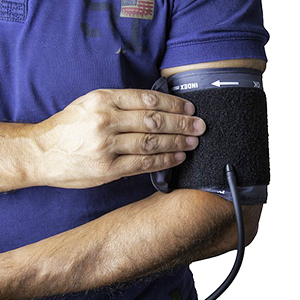Blood Pressure Values Improved Under Chiropractic Care - A Case Study
The Journal of Upper Cervical Chiropractic Research published the results of a case study on August 4, 2023, documenting the improvement in hypertension of an elderly patient receiving chiropractic care.
The authors of the study begin by noting that "Hypertension is the most common primary diagnosis in the United States and a major risk factor for cardiovascular disease." They further note that "Approximately 77.9 million people, or 1 out of every 3 people have high blood pressure in the U.S."
 Under
normal function, the human body should be able to control
blood pressure using internal mechanisms. The authors
explain the situation when the body is no longer controlling
blood pressure normally. "Patients experiencing high blood
pressure have in one way or another exhausted their natural
internal controls. The human body has regulatory mechanisms
in place to control blood pressure ensuring proper blood
flow to all organs and tissues."
Under
normal function, the human body should be able to control
blood pressure using internal mechanisms. The authors
explain the situation when the body is no longer controlling
blood pressure normally. "Patients experiencing high blood
pressure have in one way or another exhausted their natural
internal controls. The human body has regulatory mechanisms
in place to control blood pressure ensuring proper blood
flow to all organs and tissues."
In this case, a 77-year-old woman decided to go to the chiropractor. The woman had previously been diagnosed with hypertension. She was on medication for five years but was still having difficulty controlling her blood pressure. The woman reported that she was involved in a car accident 25 years earlier but suffered no injuries. She also stated that she had polio and spinal meningitis in 1952.
A chiropractic examination was performed which included a postural analysis, spinal palpation, leg length measurements, weight distribution and cervical spine x-ray. The purpose of the examination was to determine if subluxation was present in the upper cervical spine. Previous research has linked subluxations in the upper neck to blood pressure issues. From this examination and x-ray, it was determined that subluxation was present in the top bone of the neck, known as the atlas.
Specific forms of chiropractic care were started to correct the subluxation. On each chiropractic visit, a determination was made about the presence of subluxation and the need for an adjustment. The patient kept a daily journal of her blood pressure, and her blood pressure was monitored on each chiropractic visit. The study reports that as the womanís care continued, she was able to realize a 12% reduction in systolic blood pressure reading and 13% reduction in diastolic reading. The study notes that the woman continued her chiropractic care and was able to discontinue one of her blood pressure medications while still maintaining a lowered blood pressure.
In the authorsí discussion and conclusions, they stated, "Evidence within the chiropractic literature supports the positive effects of the chiropractic adjustment on hypertension." They further say, "The 77-year-old patient who experienced such a dramatic decrease in her blood pressure is a powerful example of how hypertensive patients could benefit from chiropractic care."
 In
this case, a 48-year-old man sought out chiropractic care
for help with his swallowing problems. The manís history
revealed that he had a history of some neck pain and
tightness for the past 5 years, but his swallowing
difficulties only started 8 months prior to seeking
chiropractic help. At first, the man reported a "a grabbing
sensation" in his throat, but he did not experience any pain
associated with this feeling.
In
this case, a 48-year-old man sought out chiropractic care
for help with his swallowing problems. The manís history
revealed that he had a history of some neck pain and
tightness for the past 5 years, but his swallowing
difficulties only started 8 months prior to seeking
chiropractic help. At first, the man reported a "a grabbing
sensation" in his throat, but he did not experience any pain
associated with this feeling.  The
world is well familiar with the global pandemic that we have
lived through. There has been more news generated on this
health issue than on any other in modern history. Coupled
with the vast amount of information, there has been a lot of
disinformation and conspiracy associated with this event.
Often it has become difficult to discern what is based in
science, from what is logical hypothesis, or from what is
false conspiracy stories.
The
world is well familiar with the global pandemic that we have
lived through. There has been more news generated on this
health issue than on any other in modern history. Coupled
with the vast amount of information, there has been a lot of
disinformation and conspiracy associated with this event.
Often it has become difficult to discern what is based in
science, from what is logical hypothesis, or from what is
false conspiracy stories.  According
to the National Center for Biotechnology Information,
"Obstructive sleep apnea (OSA) is characterized by episodes
of complete collapse of the airway or partial collapse with
an associated decrease in oxygen saturation or arousal from
sleep. This disturbance results in fragmented,
nonrestorative sleep. OSA has significant implications for
cardiovascular health, mental illness, quality of life, and
driving safety." It is estimated that 18 million Americans
have sleep apnea.
According
to the National Center for Biotechnology Information,
"Obstructive sleep apnea (OSA) is characterized by episodes
of complete collapse of the airway or partial collapse with
an associated decrease in oxygen saturation or arousal from
sleep. This disturbance results in fragmented,
nonrestorative sleep. OSA has significant implications for
cardiovascular health, mental illness, quality of life, and
driving safety." It is estimated that 18 million Americans
have sleep apnea.